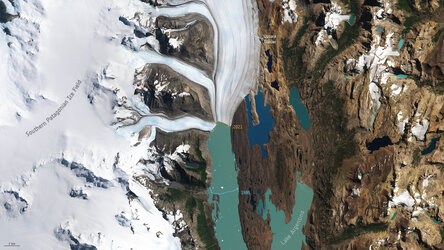
Upsala Glacier united
ESA astronaut Thomas Pesquet is spending six months on the International Space Station as part of his second space mission "Alpha". In his free time, like many astronauts, he enjoys looking out of the Cupola windows at Earth. This collage of pictures shows the Upsala Glacier in Patagonia on the South American continent.
The Upsala Glacier is the third largest glacier in the Southern Patagonian Ice Field. Many glaciers in the Patagonian Ice Field, including Upsala, have been retreating over the last 50 years owing to rising temperatures.
Earth observing satellites, including the Copernicus Sentinel-2 mission, have been closely monitoring the Upsala Glacier and have revealed that it has retreated approximately 9 km between 1985 and 2021.
Glaciers are the largest reservoirs of freshwater on our planet, and their melting or growing, is one of the best indicators of climate change. Recent studies have indicated that glaciers around the world have lost over 9000 gigatonnes of ice since 1961, raising sea level by 27 mm.
The analysis of glacial changes over time using Earth observation satellites can provide insights into past climatic fluctuations, as well as on the impacts of current climate change.
Thomas asked to have the highly-zoomed pictures aligned into this collage to allow viewers to zoom in, explore and see the details. The International Space Station flies at roughly 400 km altitude so Thomas used the longest lens available onboard: 1150 mm.
On the ground, the images were digitally rotated and assembled into this large collage made out of 34 images.
Version française
L'astronaute de l'ESA Thomas Pesquet a pris cette série de photos depuis la Station spatiale internationale pendant Alpha, sa seconde mission de longue durée. Il l'a publiée sur les réseaux sociaux avec la légende suivante :
" Une photo composite du glacier Upsala pour l’explorer en détail (34 clichés, 183 Mo !). Ce champ de glace en Patagonie est à couper le souffle. Moins réjouissant : ses glaciers constituent notre point de repère principal de la fonte des glaces et de la montée des eaux qu’elle entraîne inévitablement. Et c’est de l’espace qu’on relève cette évolution, comme un grand nombre de variables climatiques suivis par les satellites d’observation de la Terre. Si vous cliquez sur le lien, vous pourrez explorer ce glacier dans ses moindres détails. Malgré sa forme solide, on voit parfaitement, par exemple, que la glace s'écoule... très... lentement. "
Thomas a décollé à destination de la Station spatiale internationale le 23 avril 2021. Plus de 200 expériences sont prévues pendant le séjour de Thomas dans l’espace, dont 40 expériences européennes et 12 nouvelles expériences dirigées par le CNES, l’agence spatiale française.





